IPNC: Continuing Ed in Pinot Noirvana
“Despite all the comparisons between Bordeaux and Burgundy (and thus between Cabernet and Pinot Noir)
that have preoccupied us for years, no one seems to have made much of the fact that producers of Cabernet
worldwide take themselves seriously, while producers of Pinot Noir like to kick up their heels and frolic.”
Gerald Asher who attended the IPNC in1996 (Gourmet, Dec, 1996)
Asher’s comment from eleven years ago still holds true today, and 750 pinotphiles
from all over the world gravitate each summer to the small and bucolic campus of
Linfield College in Mc Minnville, Oregon, to revel in their beloved indulgence. No
homework or written tests, and no dreadful lectures at 8:00 in the morning. Just an
abundance of great Pinot Noir paired with the delicious bounty of Oregon prepared
by the Pacific Northwest’s most talented chefs, and plenty of joie de vivre.
This year’s annual International Pinot Noir Celebration (IPNC), held July 27-29,
2007, was the event’s 21st. Back in 1987, a group of grape farmers and winemakers
assembled to figure out a way to promote Oregon wine. The IPNC was born that
year and since then, IPNC has hosted a total of 237 foreign wineries and brought
over 11,000 pinotphiles from around the world to McMinnville to rejoice in their
passion for Pinot Noir. In addition, the popularity of IPNC has generated spin-offs
around the world including events in California, Wellington, New Zealnd, and the
Mornington Peninsula region of Victoria, Australia.
This year there were 66 featured Pinot Noir producers from Oregon, California,
Chile, New Zealand, Australia and France. A record number (15) of French Burgundy
domaines participated including: Maison Ambroise (Prémeaux-Prissey),
Domaine D’Ardhuy (Clos des Langres, Corgoloin), Domaine Charles Audoin
(Marsannay-la-Côte), Domaine Chateau de Chorey (Chorey-Lés Beaune), Domaine
Claude Dugat (Gevrey-Chambertin), Domaine Fougeray de Beauclair (Marsannay
la Côte), Domaine Michel Gay Et Fils (Chorey-Lés-Beaune), Domaine Aleth Girardin
(Pommard), Maison Camille Giroud (Beaune), Domaine Phillipe & Vincent
Lecheneaut (Nuits-St.-Georges), Domaine Jacques Prieur (Meursault), Domaine
Marc Roy (Gevrey-Chambertin), Domaine Taupenot-Merme (Morey-St.-Denis), Domaine
Thierry Violot-Buillemard (Pommard), and Domaine Joseph Voillot (Volnay).
The participating wineries are chosen by a board of professional tasters and acceptance into the event
is based on merit. The emphasis is on quality and stylistic diversity and many new faces appear
yearly. As Neil Becket has remarked (The World of Fine Wine, Issue 8, 2005), “We have to see beyond
the label, the name, the vintage, the points and the price to the wine itself and those with whom we
share it, receptive not only to where it has come from, but where it can take us.” There is no judging
of wines at the event. The IPNC is a pure celebration of Pinot Noir, offering the Pinot Noir lover a
chance to discover new producers and rub shoulders with established winemakers that they may have
only read or heard about. Winemakers, winegrowers and winery representatives actually outnumber
consumers here.
The IPNC is truly unique among wine festivals in that the food rivals the wine. The meals here are
always original, astonishingly fresh, and delicious. Oregon is blessed with a bounty of gastronomic
riches including wild mushrooms, an array of berries and fruits of all types, salmon, shellfish, artisan
cheeses and bakeries, home-style sausages and hams, organic dairy farms, hazelnuts, coffee roasters,
and a crop of outstanding chefs. 41 guest chefs along with 40 other professional and amateur chef
volunteers prepared the meals at this year’s Celebration. Prominent chefs at this year’s event included
Portland’s Alexis Bakouros (Alexis Restaurant), Dustin Clark (Wildwood), Tommy Habetz
(Meriwether’s Restaurant), Sue Stein (Terroir), John Taboda (Navarre), Heidi Weiser (Park Kitchen),
and Cathy Whims (Nostrana), Seattle’s Scott Staples (Restaurant Zoë), John Sundstrom (Lark), and Jason
Wilson (Crush), McMinnville’s own Laurie Lehner Furch (Red Fox Bakery), Robert Partida (La Rambla),
and Nick Peirano (Nick’s Italian Café), and Eugene’s Leif Benson (Timberline Lodge), and Rocky
Maselli and Stephanie Pearl Kimmel (Marché). Charles Ramseyer came from Wild Salmon-A Pacific
NW Brasserie on Third Avenue in New York City. He developed ties to IPNC while executive chef at
Seattle’s Alexis Hotel and Ray’s Boathouse. Every year since 1992, Frank Ostini has made the trip
from his Hitching Post II restaurant in Buellton, California, trailing all of his mobile barbecue equipment
that is used for the Saturday night Northwest Salmon Bake (below, left). It always amazes me how
the chefs (their prep tent packed with chefs for Friday night’s Grand Dinner below, right) can cook
restaurant-quality meals outdoors for 750 people.
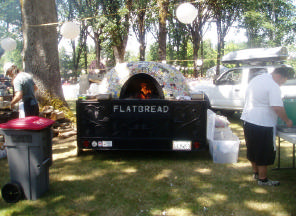
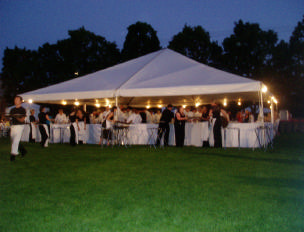
The sustainable food movement that began in Berkeley, California with chef Alice Waters of Chez
Panisse, has now become centered in Portland, Oregon. “Sustainable food” refers to a short chain of
supply and demand that emphasizes the consumption of local food. Samples of menus (Friday night’s
Grand Dinner and Saturday night’s Northwest Salmon Bake) that featured local sustainable foods:
The traditional Northwest Salmon Bake is held in an oak grove on the Linfield College campus. Now in
its 20th year, it is a much-loved tradition at the IPNC. Wild salmon is cooked native Northwest style
on wood stakes over a 60 by 15 foot custom-built fire pit fueled by fir and alder. Many volunteers from
the Depoe Bay Chamber of Commerce brave the heat and provide the succulent salmon each year for
guests. Beef, pork and veggies are grilled by Frank Ostini’s crew on traditional barbecues and a
lengthy buffet of fresh accompaniments is provided.
Wine flows like water at the luncheons and dinners. At Friday’s Alfresco Luncheon, these were the
Pinot Noirs (in addition to a few Rieslings and a Pinot Gris) served at my table:
2005 Anam Cara
Nicholes Estate Chehalem Mountains Pinot Noir, 2001 Ancien Carneros Pinot Noir, 2003 Hamilton
Russell South Africa Pinot Noir, 2005 Wild Horse Central Coast Pinot Noir, 2004 El Molino
Rutherford Napa Valley Pinot Noir, and 2003 Ponzi Special IPNC Cuvee Willamette Valley Pinot
Noir. At Saturday night’s Northwest Salmon Bake, the following wines passed through our table (there
were more but this is all I can remember);
2002 Du Mol Russian River Valley Pinot Noir, 2004
Auteur Shea Vineyard Yamhill-Carlton District Pinot Noir, 2003 Littorai Theriot Vineyard
Sonoma Coast Pinot Noir, 2003 Sea Smoke Southing Ste. Rita Hills Pinot Noir (Magnum), 2003
Martinelli Reserve Russian River Valley Pinot Noir (Magnum), 2004 Van Duzer Willamette
Valley Pinot Noir, 2003 WesMar Olivet Lane Russian River Valley Pinot Noir, 2001 Eyrie
Willamette Valley Pinot Noir, 2005 Scott Paul Audrey Willamette Valley Pinot Noir, 2004 Sine
Qua Non Ste. Rita Hills Pinot Noir, 2004 Privé Le Nord Willamette Valley Pinot Noir (maybe the
best Pinot I drank all weekend), and a very good
Belle Vallee Pinot Noir Port. There was a 3L bottle
of Chablis as well but I forget the producer. You get the idea. Hard to spit any of these terrific wines
out. Needless to say, I needed a few days to dry out when the event was over.
In the following pages, I will describe in some detail the IPNC experience and bring you the flavor of
the event. Like any successful event, it is the dedication of the “people behind” that make the experience
so memorable. The much-loved Executive Director of the IPNC, winemaker Amy Wasselman of
Westrey Wine Company, and her staff of volunteers are to be commended for keeping this Celebration
running smoothly year after year.
Portland is the gateway to Oregon’s wine country and most visitors arrive by air to Portland’s International
Airport. Portland is a hip and vibrant city with a plethora of terrific cafes, wine bars and restaurants
downtown which come alive in the summer as locals celebrate the outdoor lifestyle. The summertime
is a festive occasion to forget about rain (Oregon has more than its share during the winter)
and stow away the Pendletons. The city is known for its roses, parks, steel bridges, and eco-friendly
attitude. Wine is a big deal here, but Portland’s beer culture is without precedent in the United States.
On the same weekend that the IPNC was held in McMinnville, the 20th Annual Oregon Brewers Festival
drew over 50,000 people. Portland has more breweries and brewpubs than any other city in the
world. Beer could be one of Oregon’s winemaking secrets, for it takes a lot of beer to make good
wine.
There are five major wine touring regions in Oregon (map below). The Columbia and Walla Walla
appellations are shared by Oregon and Washington. The three western Oregon appellations are the
large Willamette Valley stretching 100 miles south from Portland to Eugene and divided into North and
South, the Umpqua Valley, and the southerly Rogue/Applegate appellation. The central Willamette
Valley is at 45 degrees north latitude, the same as France’s Burgundy region. It is the coolest region
due to Pacific Ocean influences filtering through the mountains to the west. Umpqua is a series of hills
and rivers called “the hundred valleys,” and has slightly warmer temperatures and varied soils. The
Rogue Valley has warm, sunny days and cool nights from Pacific Ocean fog. Some Pinot Noir is
grown in selected microclimates in the Umpqua Valley and show promising potential, but the Willamette
Valley is Oregon’s heartland for Pinot Noir. The Willamette Valley is home to most of the over
300 wineries in Oregon and is ideal for growing Pinot Noir, with cool winters and warm, dry summers.
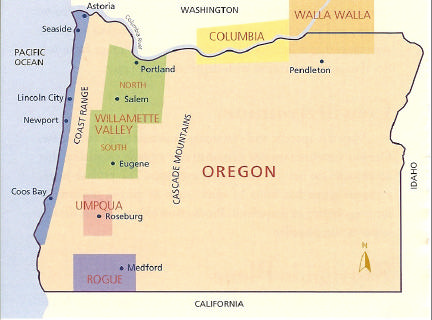
As one leaves Portland and heads south to McMinnville, about a 45 minute drive on state Highway
99W, it is easy to be overcome with culture shock. Outside of Portland, Oregon is basically a rural,
agricultural state with miles and miles of rolling hills and valleys planted with grain, grasses and
hazelnuts. Laid-back old towns dot the landscape and some seem frozen in time since the 1950s. I
noticed several striking contrasts to California. Oregonians actually observe speed limits. They drive
American cars. Service station attendants cheerfully and politely pump your gas (and gas is relatively
cheap here too). There is no noticeable disdain for old, used and weathered items including cars.
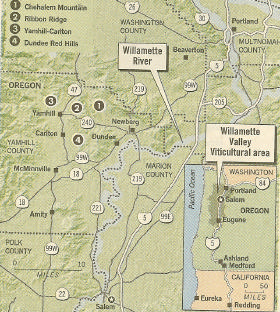
People actually greet you nicely at stores and restaurants.
They seem genuine, friendly and interested in
what you have to say. Small, independent businesses
are still plentiful, although the chains and franchises are
creeping in. There is no sales tax. The summer weather
can be quite warm (it was in the low 90s the first two days
I was in Oregon), but the evenings and mornings are
very cool. Luckily, the weather was moderate for this
year’s IPNC - perfect weather for drinking Pinot.
When I turn off Highway 99W and enter the campus of
Linfield College, my heart rate slows and I feel invigorated
by the serenity. Linfield College is a small four year
liberal arts undergraduate college established by
Baptists in 1849. The school’s President, Dr. Thomas
Hellie, is an ardent fan of the grape and was seen
throughout the event enjoying a glass of Pinot and chatting
pinotspeak with the crowd. The school’s dormitories
and student apartments (below) are opened to
attendees of the IPNC. Spartan, but roomy, they are far nicer than my college dormitory. Off campus
chain hotels and B&Bs are nearby and serviced by shuttles, but staying on campus allows you to wobble
a short distance back to your room when the day’s activities end.
Thursday night before the official IPNC kicks off, there are multiple dinners at wineries in the
Willamette Valley featuring the wines of participating wineries. I was fortunate to attend the wine
dinner at Scott Paul Wines, an artisan producer of Pinot Noir in the small town of Carlton, located about
6 miles from McMinnville. The tasting room is housed in a restored circa-1915 creamery, while the
winery across the street is in a painstakingly restructured and historic grainary. Owner Scott Paul
Wright had a successful 30-year career in the radio and record industries before becoming Managing
Director of Domaine Drouhin Oregon. After leaving DDO, he founded Scott Paul Wines and currently
works jointly with experienced winemaker Kelley Fox to craft his Pinot Noirs. Last year he launched
a Burgundy import division under the name, Scott Paul Selections, and offers visitors to his tasting
room tastes of both red and white Burgundies alongside Scott Paul’s Oregon Pinot Noirs. Three producers
from the Scott Paul Selections portfolio presented their 2005 vintage both at the IPNC and at the
special dinner I attended at the Scott Paul Winery. The Burgundy producers were: Romain Taupenot of
Domaine Taupenot-Merme, Aleth Girardin of Domaine Aleth Girardin, and Thierry Violot of Domaine
Thierry Violot-Buillermard. The wines were paired with food prepared by chefs John Sundstrom
(James Beard Best Chef Northwest 2007 of Lark Restaurant in Seattle, WA) and Tommy Habetz (of Meriwether’s
Restaurant, Portland, OR).
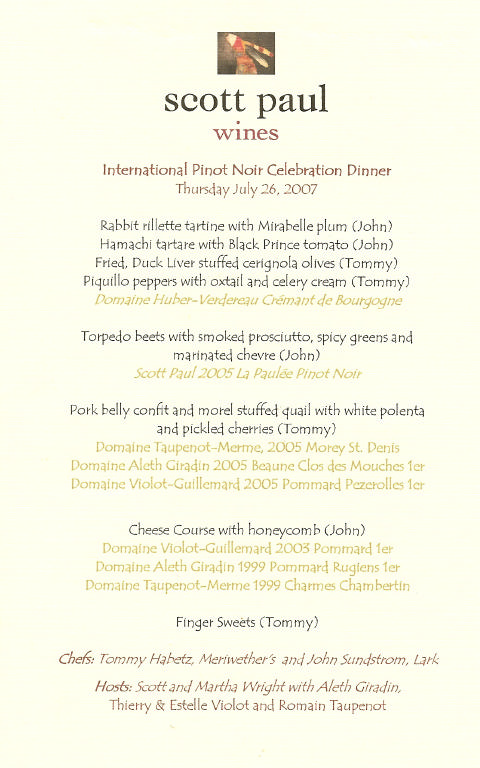
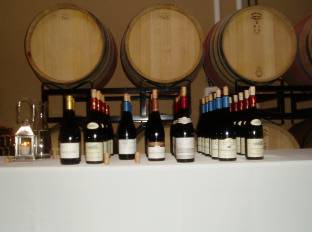
The
2005 Scott Paul La Paulée Willamette Valley
Pinot Noir was excellent with tasty spiced red fruits
and elegance to spare. The
2005 Domaine Aleth
Girardin Beaune Clos des Mouches 1er Cru was
very impressive with plenty of plush Pinot fruits but
light on its feet. The
2005 Domaine Violot-
Guillermard Pommard Pezerolles 1er Cru was
very flashy and approachable for a young Pommard.
Outrageous aromatics of ripe berries and baking
spices led to plush dark fruits enhanced by oak. Fine
tannins, juicy acidity and perfect balance. New
World in style, this wine will make a believer out of
anyone uncertain about the 2005 vintage in Burgundy.
1999 Aleth Girardin Pommard Rugiens 1er Cru
was a treat. The nose was funky but in a good way. Dark cherries, leather, vitamin flavors leading to a
prolonged finish. A surprise at the conclusion of dinner was a jerobaum of
1994 Domaine Drouhin
Willamette Valley Pinot Noir. An enjoyable wine with great freshness and vibrant fruit despite the
age. Impeccable balance. It was crafted in the Burgundian mold, but it was not as exciting or complex
as the Burgundies tasted above.
Friday morning the event kicked off with the Opening Ceremonies held on the Linfield Commencement
Green. Outgoing Head of the Board of Directors, Alex Sokol Blosser introduced the featured
speaker, Georg Riedel (left), who welcomed the attendees to the Celebration (right with Amy Wesselman).

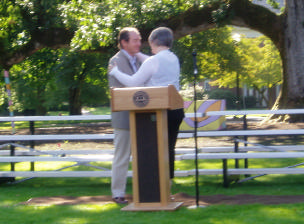
Georg Riedel (rhymes with ‘needle’) is the tenth generation to take the helm at the 250-year-old
Riedel Crystal Company. He has made it his life’s work to develop specific glasses to enhance individual
varietals. After two years of research, comparative tastings, and evaluation of multiple prototype
glasses, Georg Riedel and a panel of Oregon winemakers, wine writers, and sommeliers created
a new wine glass shape designed specifically to enhance Oregon Pinot Noir. Executive Director of the
IPNC, Amy Wesselman, was the one who first approached Georg Riedel with the idea. The glass is a
first, for not only is it a varietally specific glass, it enhances one varietal from a single wine region. During
the development process, the final three glasses chosen were the Riedel Vinum Burgundy glass,
the Vinum Extreme Pinot Noir Glass, and the Sommeliers Grand Cru Burgundy glass. The Vinum Extreme
did a good job of focusing the beautiful, fruity aromas of Oregon Pinot Noir, but exaggerated
the extraction of the wines. The Grand Cru Burgundy showed off the velvety texture of Oregon Pinot
Noir and softened the edges of younger wines. The challenge for Riedel was to design a glass that accentuated aromas like the Vinum Extreme, but delivered on the palate like the Grand Cru Burgundy.
Selections of Oregon’s best Pinot Noirs were shipped to Austria for Riedel to work with in the company’s
Kufstein plant. After six months, a final shape was delivered in the form of a large-bowled,
tulip-shaped glass that flared out gently at the top. A panel of tasters in Oregon found that the slightly
narrower opening of this glass seemed to focus aromas and its flared lip reproduced the mouth-feel
tasters had experienced with the Grand Cru Burgundy glass. It also softened the edges of young
wines much like the Grand Cru Burgundy glass. The new glass was officially unveiled at the IPNC and
is currently in use at Oregon restaurants and wineries. It is not as yet available for retail purchase.
The three finalists and the new Oregon Pinot Noir glass are pictured below. Left to Right: Vinum
Burgundy Glass, Vinum Extreme Burgundy glass, Grand Cru Burgundy glass, and Oregon Pinot Noir
glass. Three of us at Grape Radio did a brief test with Master Sommelier Rene Chazottes, pouring a
2004 Belle Valle Willamette Valley Pinot Noir into the last three glasses in the pictured series. Our
results coincided with those reported by the panel above: the Vinum Extreme tended to make the
wine seem more ripe and extracted and flashy in the aromatics and flavors while the Grand Cru
Burgundy glass delivered a more elegant and silky impression with more aromatic restraint. The Oregon
Pinot Noir glass clearly brought out the best features of both glasses according to all four tasters.
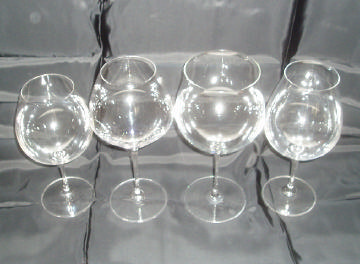
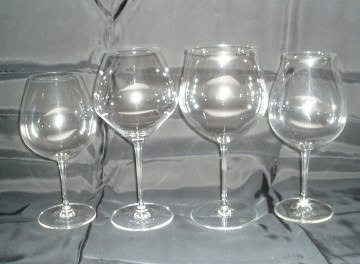
I know your first reaction is probably, “Oh no, another glass I have to buy.” I have sampled several
California Pinot Noirs from the Oregon Pinot Noir glass since returning home and can honestly say it is
comparable, if not superior, to the Vinum Burgundy style glass I am cozy with. I prefer the Oregon
glass for its tapered top which rests nicely on the lower lip. It is smaller than the Grand Cru glass making
it very comfortable to hold. Its slightly narrowed top makes for easy swirling without spilling.
When the glass becomes available, I plan to switch to using this glass for all of my Pinot Noir tasting.
One comment about evaluating aromatics in a glass of Pinot Noir. Rene showed us the proper threestep
routine. First, insert your nose in the top of the glass and sniff without swirling the wine. Second,
swirl the wine to release the aromatic esters and evaluate. Third, place your hand over the top to seal
the glass. Cradle the bottom of the bowl with your hand between the middle and index fingers, swirl
the wine, then evaluate the aromatics once again. I wouldn’t suggest doing this in a restaurant or those
around you might think you are some kind of weirdo Pinot pervert.
At the opening ceremonies, all of the participating winegrowers at the IPNC were introduced (some
winemaker photos on page 11)
Friday after the opening ceremonies I boarded a large bus for a field trip to Witness Tree Vineyard,
a 100-acre estate in the Eola Hills. The vineyard is named after an old solitary tree overlooking the
vineyard that dates to 1853 when it was used as a surveyors landmark (photo, page 13). The group was
warmly greeted by Witness Tree owners Dennis and Carolyn Devine. At the winery there was a discussion
of different Pinot Noir growing areas with emphasis on Oregon’s new AVAS. The panelists
included Heather Patz of California’s Patz & Hall (winemaker Nate Weis chimed in as well), Patrice
Ollivier of Domaine Fougeray de Beauclair, Claire Allen of Huia Vineyards in New Zealand (right),
Scott Shull of Raptor Ridge Winery in the Chehalem Mountains, and Steven Westby of Witness Tree
Vineyard (left).
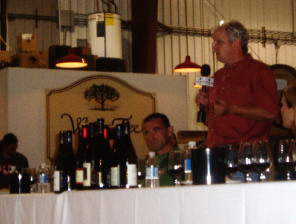
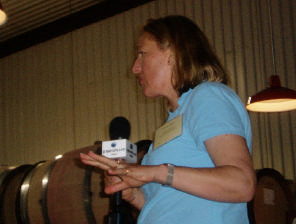
The Willamette Valley was Oregon's first formal American Viticultural Area (AVA), created in 1984.
Unofficially, it is divided into north and south halves along the 45th parallel. There are now 15 AVAs in
Oregon and 6 sub-AVAs in the Willamette Valley (McMinnville Foothill, Dundee Hills, Ribbon Ridge,
Yamhill-Carlton District, Eola-Amity Hills District, and Chehalem Mountains). The sub-AVA designations
have started to appear on wine labels (replacing “Willamette Valley”) with the 2004 and 2005
vintages. A map of the sub-AVAs of the Willamette Valley is on page 12.
Top: Scott Paul Wright and Kelley Fox (Scott Paul Wines); Middle: Jeff Stewart (Buena Vista); Bottom: Jill
and Brian O’Donnell (Belle Pente).
Key: Yellow - Chehalem Mountains, Green - Ribbon Ridge, Gray - Yamhill-Carlton District, Orange -
Dundee Hills, Blue - McMinnville, Purple - Eola Hills-Amity District
Map Courtesy of Willamette Valley Wineries Association, www.willamettewines.com.
The AVAs are largely characterized by their soils. There are two main types: (1) red volcanic basalt
soils known as ‘Jory’ from 13 million-year-old lava flows, and (2) brown marine sedimentary soils
known as ‘Willakenzie’ laid down under the ocean flow 20 million years ago. The AVAs encompass
hillsides with vineyards located between elevations of 200 to 1000+ feet. Farming grapes below 200
feet is impractical due to the threat of frost. and the presence in the valley floor is of rich, alluvial soils
which are best suited for crops such as grain, grass seed, and nut and fruit trees.
Some generalizations regarding flavor and style of Pinot Noir can be made for the appellations based
on the differences in soil type. The AVAs with Jory soils, like the Dundee Hills, Eola-Amity Hills, and
parts of Chehalem Mountains and McMinnville, tend to produce Pinot Noirs with bright red fruits including
cherry and raspberry, and are softly textured. The Pinot Noirs from AVAs with Willakenzie
soils like Yamhill-Carlton, Ribbon Ridge, and parts of Chehalem Mountains and McMinnville, typically
offer more dark fruit, spice (cola, anise), and wet leaf flavors and tend to be more tannic and structured.
By magnifying the map on page 12, you can pinpoint prominent Oregon wineries and find the
appellation they are located in. The best way to get a feel for the different appellations of the
Willamette Valley is to visit. All of the appellations are contiguous, and easily explored by car over
the course of a few days.
There were several notable wines served at the seminar at Witness Tree. The following stood out to
me: 2005 Fougeray de Beauclair St. Jacques Marsannay, 14% alc., lovely dark raspberry flavors that
persisted, 2005 Olssens Jackson Berry Central Otago Pinot Noir 14% alc., black cherry nose, vigorous
minerality and earthiness, vanilla highlights, 2005 Patz & Hall Pisoni Vineyard Santa Lucia Highlands
Pinot Noir, 15.2% alc., California ripe style, but the prodigious fruit is in balance with the alcohol.
A long finish and well-crafted. A luncheon followed out in the vineyard featuring Dungeness crab and
heirloom tomato salad with herbs (great with 2005 Witness Tree Estate Pinot Blanc), rosemary
grilled peaches with Willamette Valley goat cheese, buffalo brisket on brioche with corn salsa, and
Bing cherry crisp with Chantilly cream. My school field trips were never like this.
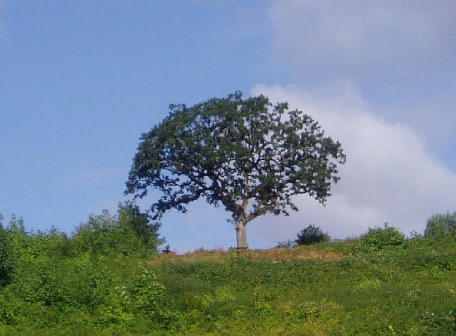
Friday night was the Grand Dinner held outdoors on a large campus lawn (menu on Page 3). The photo
below shows me toward the end of the evening, looking quite satiated and mellow and wearing the
shadows of dead soldiers on my sweatshirt.
Saturday morning broke sunny and it was off to an educational tasting
session titled, “The Secret Life of Pinot Noir; Pinot Takes a Walk on
the Sparkling Side.” A Champagne seminar at IPNC? Mais oui! If you
dig through the calcium-laden soils of Champagne, more often than
not, you will find Pinot Noir roots. Rollin Soles (Argyle Winery in Dundee)
and Ghislain de Montgolfier (Champagne Bollinger) led the
group through a tasting that explained how sparkling wine is made
and moderators Eric Asimov (New York Times) and Peter Wasserman
(Le Serbet/Selection Becky Wasserman) introduced the wines of some
of Champagne’s best grower/winemakers who were represented by
Paul and Franciose Couvreur (Champagne et Villages), Morgane
Fleury (Champagne Fleury), José and Corinne Lievens (Champagne
Jacques Picard), and Thierry Massin and Slyvie Fricot (Champagne
Thierry Massin).
I recorded the Champagne seminar and the full content will be available
as part of a featured show on the IPNC on Grape Radio. There
were a number of interesting factoids and revelations during this very
enlightening presentation.
There are 350 villages in Champagne. 17 whole villages are Grand
Cru, 23 are Premier Cru and the rest are Cru.
The traditional coupe glass was actually developed for sweet, bubbly
dessert Champagne and to avoid spillage when standing at a reception.
Flutes have continued to be used for dry Champagne since 1930
when the now familiar dry style of Champagne became popular.
Dry Champagne is best served in flutes because they best show off the aromas of the high-quality base
wines from which Champagne is made. However, Champagne is often served either in coupes or in
glasses that are too small and are filled to the brim, neither of which conveys the aromatics. The
Riedel Sommelier Vintage Champagne glass is ideal. It should be filled with about 4 oz of Champagne
(it holds almost 12 oz). The diameter is larger than the traditional thin flute and concentrates the yeasty
aromas of Champagne. The bubbles do not dominate and the creamy texture can be appreciated.
The carbonic gas in Champagne allows it to age longer than comparable still wines. No unique clone
is used for Champagne - the clones are the same as for still wine. However, the viticulture is different
with emphasis on acidity and freshness rather than concentration.
During the first part of the Champagne Seminar, we had the rare opportunity to sample a Pinot Noir
base wine from which Argyle and Bollinger make their sparkling wines. The base wines have undergone
primary fermentation only (a secondary fermentation occurs in the bottle) in neutral barrels. The
base wines are rather acidic and not particularly pleasant drinking but they are not intended to be.
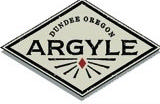
At Argyle, the grapes for sparkling wine are picked earlier when apple
flavors are dominate. Once strawberry and cherry flavors develop in the
grape, it is too late for sparkling wine. The Argyle base wine that was offered
was from vines dating to 1971 and showed a definite apple flavor with a hint
of plum, The base wine was pale yellow in color as only the heart of the
grape (sans skins) is used. At Argyle, there are at least 50 base wines from
every vintage which are sourced from different blocks and clones. They are
then assembled to retain the Argyle style and reflect the vintage. The sparkling wines from Argyle are
vintage driven and no attempt is made to duplicate the wine year after year by blending in base wine
from other vintages. Some base wine is retained from each vintage for dosage (the addition of liquefied
sugar and yeast to the bottle to stimulate secondary fermentation).
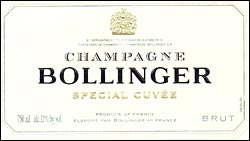
A 1985 Reserve base wine from Bollinger was presented. From 35 different
terroirs, 6 or 7 of the best wines are kept at Bollinger as a base to balance each
vintage and to create the special house or cuveé style. About 60,000-100,000
magnums are retained each vintage. The base wine is bottled in magnums for
age ability. Several years of base wine are used to create the final cuveé and
make up 5-7% of the total finished Champagne.
NV Bollinger Special Cuveé
A blend of 250 different base wines. The margins for error in
blending and dosage are very slim in order to create a consistent house style. Yeasty flavors in Champagne are
due to the extended time that yeast is in contact with the wine and the minerality is attributable to the
fact that the vines in Champagne “have their feet in chalk.”
·
Beautiful mousse,
yeasty aromatics with a burst of citrus and minerals in a clean finish.
1999 Bollinger Grand Année
Each bottle is dosaged by hand. The wine is kept several years
before release.
·
Striking perlage (steady stream of tiny bubbles). This is a Champagne of great breeding
with a purity and minerality that is stunning and a finish that lasts forever.
Note: Retail prices in the United States for Champagne vary considerably. Consult a wine price
search guide such as www.winezap.com to find the best deals.
The Champagne Seminar continued with a session on grower Champagnes. Moderator Eric Asimov
commented that grower Champagnes are quite terroir specific and not a blend or house style. They
are more distinctive wines and a completely different way of thinking about Champagne. A prime
area for grower Champagnes is the Montagne de Reims.
We tasted a series of seven grower Champagnes ranging from a Blanc de Blanc (100% Chardonnay) to
a Brut Rosé (100% Pinot Noir). The most striking feature of the Pinot Noir-based Champagnes is the
“sweet” fruit that Pinot Noir contributes. Pinot Noir supplies the power with grace. Because of the
fruitiness of Pinot Noir-driven sparkling wines, the wines can be paired with heartier foods such as
lamb and venison. The tasting comments that follow were from Eric Asimov and Peter Wasserman.
NV Vazart-Coquert Brut Reserve Blanc De Blanc Grand Cru
$50. The Vazart-Coquert family has
been involved in the wine business for centuries. In 1953, Louis Vazart and his son Jacques launched
the brand. Jean-Pierre Vazart, Jacques’ son, is now in charge of the estate. The Vazarts grow 95%
Chardonnay and 5% Pinot Noir on their 26.4 acres in Chouilly. Average vine age is 30 years. This
wine is 100% Chardonnay and is considered to be one of the best Blanc de Blancs in Champagne.
·
Yeast on the nose, freshness on the palate, with a long mineral-laden finish.
NV Camille Savés Carte Blanche Brut Premier Cru
The Camille Savés family has been growing
vines and making Champagne since the end of the 19th century. Founded in 1894 by Eugene
Savés, his successors, Louis, Camille, and now Hervé have been running the family business ever
since. The estate’s 22 acres is located mainly in the territory of Bouzy Grand Cru. The soil is chalky
and covered with a rich limestone that gives the Champagne full body and great structure. The wines
do not go through ML which yields a more refined and lively Champagne. The bottles mature at least
four years in the cellar and Hervé riddles the bottles by hand every day. 75% Pinot Noir, 25% Chardonnay,
Montagne de Reims.
·
The nose is quite robust. In the mouth, the wine makes your palate snap to
attention. There is a refreshing texture, a hint of minerality, and a long finish.
NV Fleury Carte Rouge Blanc
The vineyards of the house of Fleury are located near the village
of Courteron in the valley of the Seine. After phylloxera invaded Champagne in 1901, Emily Fleury , a
botanist and viticulturist, became the first to plant grafted Pinot Noir vines in the area. In 1989, Jean-
Pierre Fleury became the first Champagne producer to use biodynamic practices. 100% Pinot Noir,
Côte des Bar. A blend of the 2003 and 2004 vintages.
·
Gold in color. Floral notes in the aromatics.
Creamy and roundness with plenty of power. Red berry tones among the flavors. The finish has lively
acidity and is quite “tranquil.” My favorite Champagne in the lineup.
NV Thierry Massin Brut Selection
The Massin vineyards overlook the village of Ville Sur Arce.
Limestone soils produce exceptional Pinot Noir, which is both structured and elegant. The Massins
practice culture raisannée meaning they work parcel by parcel. Wines are vinified and bottled at the
estate and spend three years ageing in the cellars. Brother and sister Thierry and Dominque took over
the family estate in Aube in 1977. The Massin family have been independent Champagne producers
for 30 years, making them pioneers among grower Champagne vintners. 75% Pinot Noir, 25% Chardonnay,
Côte des Bar.
·
A touch of yeast and floral qualities on the nose. A little richer in the mouth with
plum and herbal flavors. Very focused and precise with a powerful attack. Mineral notes on the finish.
Delicious and a real sense of maturity. Try with lamb.
2002 Jacques Picard Premier Cru Blanc de Noir
Picard is the only récolant-manipulant in the Mont
de Bern. Most of the other growers use a cooperative or sell grapes to the principal Champagne
houses. The Picard estate practices “involved viticulture,” without getting into biodynamic fanaticism.
They not only press and vinify parcels separately, but go so far as to treat each different clonal selection
individually. 100% Pinot Noir, Montagne de Reims.
·
Young with floral and berry aromas. Plenty of
weight and density with a lot of Pinot Noir flavor. A high acid finish.
NV Godmé Grand Cru Blanc de Noir
The Godmé family has been producing Grand Cru Champagne
since 1830. Today the winemaking is a family affair with the younger generation of husbands
and wives working as a team. They own 27.6 acres in five villages in the Montagne de Reims area.
The average vineyard age is 25 years. Two parcels are over 50 years old. The Godmés subscribe to
culture raisonnée in the vineyards. 100% Pinot Noir, Montagne de Reims.
·
Strawberry and anise notes in
the nose. Dry, rich, and potent with plenty of power and minerality.
NV Thierry Massin Brut Rosé
100% Pinot Noir, 85% vinified as a white Pinot Noir. Base wine is from
2003 and 2004 with addition of red wine from 2004.
·
Brilliant pink in color. Dry roses in the nose. Flavors
of wild strawberries and raspberries. Acidity picks up the fruit on end. Pair with meat and desserts.
On both Friday and Saturday afternoons, there were numerous activities including tasting more
Pinot Noir (Old Vines vs Young Vines, Coast to Coast in California), a humorous International Wine
Jargon Jeopardy, a Pinot Lab (play winemaker for a day), a Photographic Tour of Cellars and Vineyards
of winery participants, Jazz and Iced Tea, and just plain snoozing on the lawns. Late afternoons
were spent at the Alfresco Tastings where wineries poured Pinot Noirs from the 2004 and 2005 vintages.
At the Friday Alfresco Tasting, each attendee was presented with a complimentary Riedel
Crystal Oregon Pinot Noir glass. The Pinot Noirs were all stellar, but there were several that really
stood out. These are noted below.
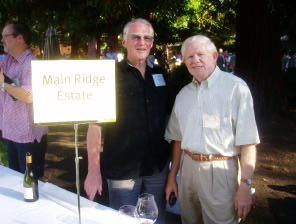
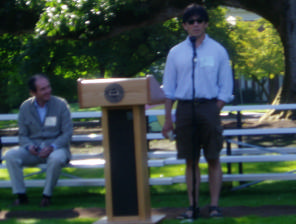
2004 Main Ridge Estate Mornington Peninsula Victoria Australia Pinot Noir
Main Ridge Estate
was the first commercial winery on the Mornington Peninsula in 1975. Owner Nat White (photo below)
was inspired by a visit to Burgundy in 1966. The 7.5 acre vineyard is planted on deep red balsatic soils
and dry farmed. Intense human intervention in the vineyard enables minimal intervention in the winery
where natural yeast and bacteria are utilized to help define the site characteristics.
·
A Pinot Noir of
great elegance and grace with plenty of fruit interest. Website: www.mre.com.au.
2006 Kingston Family Vineyards Alazan Chile Pinot Noir
CJ Kingston headed to Chile
around 1900 looking for gold. Five generations later, his descendents are taking Chilean winemaking
in new directions. Located in coastal Casablanca Valley, Kingston Family is making Pinot Noir under
the guidance of American Byron Kosuge (formerly Saintsbury, currently Miura, B. Kosuge Wines, pictured
below). Some Kingston Family Vineyards Pinot Noir is
exported to the United States and it is worth seeking out. Website: www.kingstonvineyards.com.
·
A real surprise with abundant Pinotosity.
2005 Domaine Claude Dugat Charmes Chambertin
This estate owns over 15 acres of Pinot Noir
vines, exclusively planted in Gevrey-Chambertin. Current annual production is about 2,000 cases.
Claude’s children, Laetitia and Bertrand Dugat have recently begun working at Domaine Dugat.
·
Intense aromatics that make a real impression. A young wine with tremendous power and structure. Very
good material here.
2005 Domaine Fougeray de Beauclair Bonnes Mares
In 1972,
Jean-Louis Fougeray created Domaine Jean-Louis Fougeray. Over
the years, the domaine grew to 25 acres with vineyards stretching
from Marsannay to Savigny-les-Beaune. In 1986, Jean-Louis partnered
with Bernard Clair to form Domaine Fougeray de Beauclair.
This estate now owns 54 acres of vines, and bottles the only Bonnes
Mares originating from the Morey-St.-Denis side of this Grand Cru
vineyard. Current annual production is 10,000 cases. Patrice Oliver
has been the winemaker since 1999. This is a superstar domaine that
manages to keep its prices within reason (see also pages 10 and 13).
·
The Bonnes Mares from this domaine
is always unusually approachable early in its evolution. This wine has the whole package from start
to finish and is magnificent. Power with elegance.
2005 Domaine Aleth Girardin Pommard Epenots 1er Cru
Aleth’s domaine is comprised of very old
plantings in Pommard Villages, Beaune-Clos des Mouches, and three Pommard Premier Crus - Charmots,
Epenots, and Rugiens-Bas. The latter two are parcels planted in 1906, some of Burgundy’s first
post-phylloxera re-plants. Aleth’s wines are as graceful and elegant as the woman herself. Yields are
kept extremely low in the vineyard and new oak is kept to no more than 33%. Some whole-cluster fermentation
is employed depending on the vintage. See also page 7 and 8.
·
Girardin’s 2005 wines have great charm and are very
drinkable now. There is no trace of Burgundian rusticity, just lush fruit that is focused and precise. I am
going to seek out the wines for my own cellar.
2005 Maison Camille Giroud Beaune 1er Cru Cent Vignes
Maison Camille Giroud was founded in
1865 and is one of the last small negociant firms in Burgundy. Giroud has always specialized in wines
that age and still has small stocks in the cellars of vintages going back to 1937. Maison Giroud was
purchased in 2002 by an American group. Winemaker David Croix is not a “modernist,” but believes
that the most important factor in producing Burgundies true to their appellation is the work that is done
in the vineyards. Croix uses a wooden press for the red wines, open wooden vats for fermentation,
and no new oak barrels. David comes to the IPNC every two years. This year he sported a T-shirt which said
on the front, “Dogma Kills Pinot,” and on the back “Terroriste.”
·
The absence of noticeable oak is readily apparent in Croix’s wines. Unlike the
Giroud tradition, his wines are readily accessible when young. This wine had a lush core of red fruits,
ever-expanding flavors, attractive spice, creamy texture and a respectable acid spine. Understated, but
entirely seductive.
2005 Domaine Phillipe & Vincent Lecheneaut Nuits-St.-Georges 1er Cru Les Pruliers
Fernand
Lecheneaut created this 22-acre estate in the early 1960s while he worked for a negociant in Beaune.
His sons Phillipe and Vincent took over in 1985. All their vines are in the Côte de Nuits spread through
Nuits-St.-Georges, Morey-St.-Denis, Vosne-Romanee and Chambolle-Musigny, with a small parcel of
the Grand Cru Clos de la Roche. Production is 6,000 cases per year with 13 different bottlings.
·
The
hype about 2005 Burgundy seems to be warranted. Perfumed with cherries and roses, opulent and layered
with a citric tang, the finish is long and stylish.
2005 Domaine Thierry Violot-Guillemard Pommard 1er Cru Rugiens
Thierry is quite noticeable with his walrus mustache, a bad limp from a terrible auto accident, a
beautiful wife at his side, and a sparkle in his eye. His wines are some of the most graceful and
elegant of the Côte de Beaune. His parcels in Pommard, Beaune Clos des Mouches, and several
Pommard Premier Crus yield wines that are quite delicate for the appellations.
·
This is the wine Thierry
is most noted for. A superb Pommard that has not shed all of its youthful tannic backbone, but give this a
couple of years and as Dick Enberg would say, “Oh, my.”
2005 Domaine Joseph Voillot Volnay 1er Cru Les Champans
This domaine has 25 acres in Volnay
and Pommard. Son-in-law jean Pierre Charlot, who worked closely with Joseph from 1980 until 1995, is
now the director.
·
Soft, plush, long and tasty. Plenty of flavor and character with great finesse.
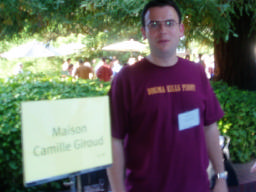
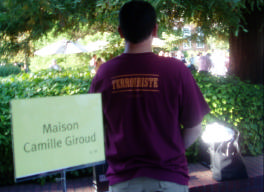
2005 Beaulieu Vineyard Reserve Carneros Pinot Noir
$35. Beaulieu Vineyard
has over 100 years of tradition in winemaking in the Napa Valley.
Beaulieu farms over 1,100 acres. The winemaker is Joel Aiken. Beaulieu is
best known for Cabernet, but this Pinot Noir delivers.
·
Fermentation is carried
out in 18-ton open-top fermentors. A flamboyant California styled Pinot Noir with
heady aromatics, thick fruit and oak flavors, and great rigor. Pretty good value
also.
2005 Cuvaison Block F5 Carneros Pinot Noir
Cuvaison has been producing Pinot Noir from their
estate vineyards in Carneros since 1987. With a renewed commitment to quality and a new winery in
the vineyard specifically constructed for the production of Pinot Noir, the wines have gone from good
to great. Winemaker Steve Rogstad crafts 4,500 cases of Pinot Noir annually, divided into three estate grown
bottlings - Carneros, Mariafeld, and Block F5.
·
$50. This is the best Cuvaison Pinot Noir I have ever
sampled. A serious wine with earth, toast and dusty black cherry flavors and appealing notes of minerality
and spice. Very tasty.
2004 El Molino Rutherford Napa Valley Pinot Noir
14.8% alc., 873
cases, $60. El Molino was founded in 1871 and was one of the first
wineries in the Napa Valley. It operated until Prohibition and was restored
in 1981. The estate Star Vineyard, planted in 1978, is located in
a unique microclimate ideal for growing Pinot Noir and Chardonnay.
The Proprietors are Lily Oliver and Jon Berlin. The Pinot Noir is aged
in 70% new Francois Freres oak.
·
An interesting and heady Pinot Noir
which shows a wide range of flavors and a lengthy finish. A distinctive
wine reflecting its unique origins. I have drank the El Molino Pinot Noirs
for years and always enjoyed them.
2005 Lynmar Winery Five Sisters Russian River Valley Pinot Noir
The Fritz family purchased the Quail Hill Vineyard in 1980 and
founded Lynmar Winery in 1990. In 2004, the winery launched a five year
investment plan to complete a phased replanting of Quail Hill. An
impressive new winery and hospitality center has been added. Winemaker
Hugh Chapelle (and consultant Paul Hobbs) have brought
Lynmar to a world-class level. All of the wines in the portfolio are superb,
including a fine Rosé, a classic Russian River Valley Chardonnay,
and serious Pinot Noirs 2004 marked the return of the Five Sisters bottling which has not been produced
since 1999. It represents the best barrels in the cellar and is a homage to Lynn Fritz’s five
daughters.
·
This is a wine of great power with waves of sappy current fruit and notes of tea and stylish
spice. The mouth feel is refined and the notable acidity provides a clean and refreshing finish. A Pinot
Noir of great pedigree with verve and punch to spare. One of my favorite wines tasted during the event.
2005 Argyle Winery Spirithouse Willamette Valley Pinot Noir
Argyle dates back to 1987 and now
farms over 350 acres of vineyards in the Dundee hills and Eola Hills-Amity District AVAs. The focus of
winemaker and owner Rollin Soles is on farming vintage-driven wines from great sites. Argyle is one
of the few wineries still making sparkling wine in Oregon.
·
A ‘spirited’ wine with a
memorable finish of ripe strawberries and raspberries. Just plain terrific.
2004 Belle Pente Estate Reserve Willamette Valley Pinot Noir
Owners Jill and Brian O’Donnell farm an historic 70-acre estate in the
Yamhill-Carlton District. Belle Pente (‘bell pont’) means “beautiful
slope.” The estate’s 12 acres of Pinot Noir is closely planted and
farmed using organic and biodynamic principles. The Estate Reserve
Pinot Noir is a selection of individual barrels from the best sections of
the vineyard, aged for at least 18 months in barrel. Website: www.bellepente.com.
·
Like previous Belle
Pente Pinot Noirs I have enjoyed over the past few years, this is another winner. The wine has a refined
mouth feel and just the right touch of acidity. If you love classic Pinot Noir with charm and elegance, this
is your cup of tea.
2005 Brandborg Vineyard & Winery Ferris Wheel Estate Umpqua Valley Pinot Noir
12.9% alc., 250 cases, $35. Terry and Sue Brandborg grow Pinot Noir in Elkton, which is situated in the northernmost reach of the Umpqua Valley. At an elevation of 900 feet, the vineyard features southern slopes
and sandy loam soils. There is plenty of marine influence with morning fog and afternoon sea breezes.
A new winery and tasting room was built in Elkton on Highway 38. Terry has 17 years of commercial
winemaking experience. Terry and Sue are bright and enthusiastic and will most certainly put the Umpqua Valley on the Oregon Pinot Noir map. Website: www.brandborgwine.com.
·
This wine is from young vines, and although not showing the complexity that
will come with more vine age, it is very pleasant to drink. Technically it is well crafted and impeccably
balanced.
2005 Broadley Vineyards Shea Vineyard Yamhill-Carlton Pinot Noir
Family-owned Broadley Vineyards was established in 1982 in the hills west of
the town of Monroe. Today, founders Craig and Claudia Broadley are joined
by the second generation of Broadley winegrowers, son Morgan and his wife
Jessica. The 33-acre estate vineyard is planted to the classic Oregonian
clones, Pommard and Wädenswil. The winemaking style employs a high
percentage of whole cluster fermentation. Pinot Noir bottlings include a
Willamette Valley blend, an Estate, a Reserve, Marcile Lorraine (old vine
block), Claudia’s Choice (a distinctive old block of the vineyard), and Shea Vineyard.
·
This wine has
plenty of stuffing and features darker fruits, roasted meat, spice and smoke. The tannins are fine-grained.
An impressive effort by any standards.
2004 Chehalem Reserve Chehalem Mountains Willamette Valley Pinot Noir
Chehalem (‘Chuh-hay-lum’) is an American
Indian word meaning “gentle land” or “valley of flowers.” This winery is owned by Harry Peterson-
Nedry and Bill and Cathy Stoller. Chehalem has three distinct estate vineyards, Ridgecrest,
Stoller, and Corral Creek. The Reserve Pinot Noir is chosen from select barrels, primarily from Ridgecrest
Vineyard. Website: www.chehalemwines.com.
·
Very nice restraint here but plenty of zip and zing. The balance is right on. This is
almost too good for mortals.
2005 Soter Beacon Hill Yamhill-Carlton District Willamette Valley Pinot Noir
$39. Noted winemaker
Tony Soter (Etude) has recently moved to Oregon for good and is
crafting Pinot Noir from his 20-acre hillside Beacon Hill Vineyard on the
north fork of the Chehalem Valley. The Soter philosophy is to craft limited
quantities of superb wines that fully express their sites, and in doing so
remain stewards of the land and conscious of the well-being of future generations. Tony also produces a terrific Vin Gris of Pinot Noir and a
marvelous Brut Rosé.
·
A comforting wine with ripe fruit aromas, cherry and cocoa flavors,
coating tannins, and a long and intense finish.
2004 Twelve Yamhill-Carlton District Pinot Noir
680 cases. Twelve is a very small, family owned producer of
Pinot Noir. This is John and Linda Lenyo’s second vintage. After many years of work, they expanded
an existing 5-acre vineyard into 11 acres of now 7 to 22-year-old Pinot Noir (Pommard, Wädenswil,
115) and 2 acres of 12-year-old Pinot Blanc.
·
This was quite nice with a deep
cherry nose and palate.
2005 Willakenzie Estate Pierre Léon Willamette Valley Pinot Noir
Bernard and Ronni
Lacroute purchased a 420-acre ranch in the hills of the Chehalem Valley in 1991. Over 100 acres have
been planted to the Pinot family of grapes. A modern winery was built in 1995. The winemaker is
Thibaud Mandet. This winery produces consistently fine Pinot Noirs.
·
This is a wine I could sip all night.
Fresh and sweet-flavored Pinot extract which leaves a lasting impression.
The Sparkling Finale Brunch in Pink was held on Sunday morning. The conclusion of the IPNC is traditionally
a brunch buffet of favorite international dishes from several of the Northwest’s most popular
restaurants. This year the featured wines were all rosés: 2001 Soter Beacon Hill Brut Rosé (Oregon),
R. Stuart & Co. Rosé d’Or (Oregon), Schramsberg Brut Rosé (California), and Jean Laurent Brut
Rosé (France). (No tasting notes as I had no intention of pursuing the hair of the dog after the many
Pinots I sampled the night before at the Salmon Bake). This is a more casual affair where the Maitres
d’Hôtel , who volunteer their time to serve wine to the attendees throughout the event, wear
outrageous clothes centered around portions of their more traditional formal wear (think pink tennis
shoes, boas for the women, shorts etc.). All in all, it is a raucous conclusion where everyone lets their
hair down and as Gerald Asher noted, is prone to “kick up their heels and frolic.”
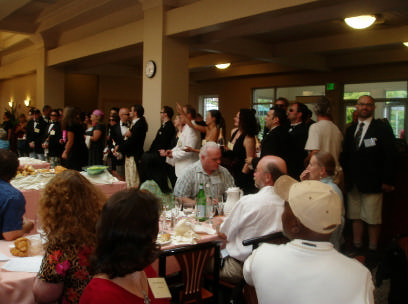
When Lewis and Clark arrived at the mouth of the Columbia River that divides Oregon and
Washington states, the foul weather led their group to call this region Point Dismal. I am sure they
would be startled today see the expansive vineyards that now dot the Oregon landscape and to taste
the magnificent Pinot Noirs that are now an Oregon trademark. The winter rain may be mother
nature’s dismal side, but she has delivered a wonderful gift as well - Oregon Pinot Noir.
Next Year’s 22nd Annual International Pinot Noir Celebration will be held at Linfield College, July 25-
27, 2008. You can register now at www.ipnc.org or by calling 800-775-4762. Full Weekend tickets
only: $795 pp.
In the next issue I will briefly review the history of Pinot Noir in Oregon and the vintages since 1990. In
addition, I will feature wineries (most of which I visited before and after IPNC) which I believe are
representative of the best that Oregon currently has to offer: Anam Cara, Anne Amie, Capitello,
Cardwell Hill Cellars, et Fille, Scott Paul Wines, Premier Pacific Vineyards, and Shea Wine Cellars.
The revitilization of the small town of Carlton in the heart of the Willamette Valley will also be featured
in words and photos.